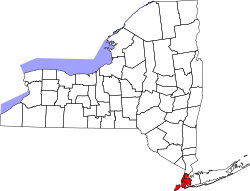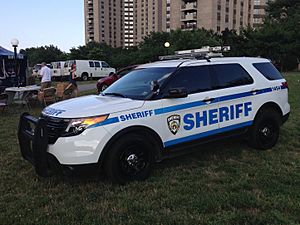New York City Sheriff's Office facts for kids
Quick facts for kids Office of the Sheriff of the City of New York |
|
|---|---|

Patch of the New York City Sheriff's Office
|
|

Flag of the City of New York City Sheriff's Office
|
|
| Common name | New York City Sheriff's Office |
| Motto | New York's First |
| Agency overview | |
| Formed | 1942 |
| Jurisdictional structure | |
| Operations jurisdiction | New York City, New York, U.S. |
 |
|
| Map of Office of the Sheriff of the City of New York's jurisdiction | |
| Size | 468.484 square miles (1,213.37 km2) |
| Population | 8,537,673 (2017) |
| Legal jurisdiction | New York City |
| General nature | |
| Operational structure | |
| Deputy sheriffs and investigators | 150 |
| Agency executive |
|
| Parent agency | New York City Department of Finance |
| Facilities | |
| County field offices | 5
List
New York County Field Office for Manhattan
Queens County Field Office for Queens (Headquarters) Bronx County Field Office for The Bronx Kings County Field Office for Brooklyn Richmond County Field Office for Staten Island |
The New York City Sheriff's Office (NYCSO) is the main law enforcement agency for New York City that handles civil law. This means they help make sure court orders are followed in non-criminal cases. The Sheriff's Office is part of the New York City Department of Finance. They help with things like investigating cigarette tax issues and property fraud.
They also make sure that different orders from the New York State Court System are carried out. This includes things like evictions, taking property, and making arrests related to civil cases. They even hold auctions for property they have legally taken.
Contents
History of the Sheriff's Office
The New York City Sheriff's Office started way back in 1626 when New York was called New Amsterdam under Dutch rule. Later, when the English took over, it became the New York County Sheriff's Office.
From County Sheriffs to One City Sheriff
Originally, each of New York City's five areas (called boroughs or counties) had its own sheriff. These sheriffs were elected and had a lot of power in their areas. After the city became one big city in 1898, the New York City Police Department started handling most policing and criminal investigations. The Sheriff's Office then focused on civil law and managing county prisons.
In the past, sheriffs were paid by charging fees for their work. But by 1915, this changed, and they started getting a set salary. The fees they collected then went to the city. In 1938, a woman became a deputy sheriff for the first time!
On January 1, 1942, all five county sheriff's offices joined together. They became the Office of the Sheriff of the City of New York. The city's mayor now chooses the main sheriff. This change helped make the office more professional. At the same time, the job of running prisons moved to the new New York City Department of Correction.
Understanding the Ranks
The Sheriff's Office has a clear system of ranks, just like other law enforcement agencies. This helps everyone know their role and who is in charge.
| Title | Insignia | Badge design | Uniform shirt color |
|---|---|---|---|
| Sheriff | Medallion with eagle and five stars |
|
|
| First Deputy Sheriff | Medallion with eagle and four stars |
|
|
| Chief of Staff | Medallion with eagle and three stars |
|
|
| Deputy Sheriff - Lieutenant | Medallion with Rank |
|
|
| Deputy Sheriff - Sergeant | Shield with eagle |
|
|
| Deputy Sheriff | Shield |
|
To become a deputy, people must pass an exam and meet certain education or experience rules. They also need to pass medical and psychological tests. Plus, they must pass physical tests and a full background check. The Sheriff's Office also has criminal investigators and other staff who help out.
As of May 3, 2022, Anthony Miranda is the 122nd Sheriff of the City of New York.
The uniform for the Sheriff's Office is usually dark blue. It includes a shirt with a metal badge, dark blue pants, a tie, a jacket, and a peaked cap. Some units wear a more casual version without metal badges. They might wear vests, gloves, and other gear depending on the weather or their job.
How the Office Works
The New York City Sheriff's Office has three main parts: Operations, Intelligence, and Support. Each part has different jobs to help the city.
Operations Section: On the Front Lines
The Operations section includes the five county field offices and other citywide units. Deputy sheriffs in these offices handle civil law enforcement. They do many tasks like evictions and serving civil arrest warrants. They also seize and sell property based on court orders.
They target businesses and people who owe the city money. This includes unpaid taxes or fines for breaking city rules. These deputies also deliver many legal documents, with protection orders being a top priority. Each field office has staff to help with paperwork and customer service. This makes it easy for people to file court documents that need to be enforced.
Deputies in Operations might also work on other tasks. This includes arresting people for other city agencies like the Human Resources Administration. They might also help with security at the city treasury.
Intelligence Section: Gathering Information
The Intelligence section includes the Bureau of Criminal Investigation (BCI) and the Intelligence Unit. The BCI looks into city tax violations, property fraud, and other crimes against the Department of Finance. The Intelligence Unit gathers and studies information from many sources. This information is then used by the agency to help with their work.
Support Section: Keeping Things Running
The Support section handles important services for the agency. This includes communications, managing seized property, and destroying evidence safely. They also provide field support services to deputies working out in the city.
Powers of the Sheriff's Office
Deputy sheriffs and criminal investigators are considered New York State peace officers. This means they can make arrests without a warrant and issue tickets. They can also carry and use firearms, tasers, batons, pepper spray, and handcuffs.
Deputy sheriffs are also civil enforcement officers. This means they can make sure the New York State Civil Practice Law and Rules are followed. These rules are about how civil cases are handled in court.
Special Officers
The Sheriff's Office also has special officers. These officers help the deputy sheriffs and criminal investigators. Their uniform patch looks similar to the NYPD's School Safety and Traffic Enforcement divisions. It says "PUBLIC SAFETY" to show they are different from deputies. Special officers work with deputies and detectives. They also act as bailiffs in court and protect the NYC Finance Administrative Hearings Tribunal.
Special Officer Ranks
- Special Officer
- Special Officer Sergeant
Officers Who Died in the Line of Duty
Since the sheriff's offices were created in New York City, seven officers have died while on duty.
| Officer | Department | Date of death | Details |
|---|---|---|---|
| Deputy Sheriff Isaac Smith | Bronx County Sheriff's Office |
|
Gunfire |
| Deputy Sheriff Henry Wendelstorf | Queens County Sheriff's Department |
|
Assault |
| Sheriff Paul Stier | Queens County Sheriff's Department |
|
Gunfire |
| Keeper Morris Broderson | Bronx County Sheriff's Office |
|
Gunfire |
| Keeper Daniel D. Horgan | Bronx County Sheriff's Office |
|
Gunfire |
| Deputy Sheriff John T. Miller | Queens County Sheriff's Department |
|
Automobile accident |
| Deputy Sheriff Fred D'Amore | Queens County Sheriff's Department |
|
Automobile accident |
Past Sheriffs of New York City

Since January 1, 1942, one citywide sheriff has served all five counties in New York City. The mayor of New York City appoints this position. Here is a list of the citywide sheriffs since the offices merged:
| Order | Name | Term | Notes and references |
|---|---|---|---|
| 106 | John J. McCloskey | 1942–1971 | He was the first to serve all five counties. |
| 107 | H. William Kehl | 1971–1973 | |
| 108 | Joseph P. Brennan | 1973–1974 | |
| 109 | Frederick Weinberger | 1974–1975 | Acting sheriff |
| 110 | Edward A. Pichler | 1975–1987 | |
| 111 | Vincent M. Pharao | 1987–1989 | |
| 112 | Harry Weisberg | 1989–1990 | Acting sheriff |
| 113 | Philip A. Crimaldi | 1990–1994 | |
| 114 | Kerry Katsorhis | 1994–1995 | |
| 115 | Raul Russi | 1995–1996 | |
| 116 | Teresa Mason | 1996–2000 | First female to serve as sheriff of New York City |
| 117 | Henry Coira | 2001–2001 | Acting sheriff |
| 118 | Caliph T. Mathis | 2001–2002 | |
| 119 | Lindsay Eason | 2002–2010 | |
| 120 | Joseph Fucito | 2010–2011 | Acting sheriff |
| 121 | Edgar A. Domenech | 2011–2014 | He was the 121st Sheriff of New York City including acting sheriffs in the count. |
| 122 | Joseph Fucito | 2014–2022 | |
| 123 | Anthony Miranda | 2022–present |
Images for kids
See also
- List of law enforcement agencies in New York
- Law enforcement in New York City
- Coroner of New York City



